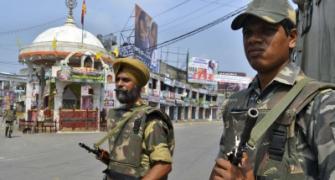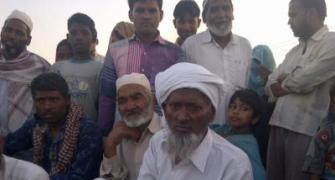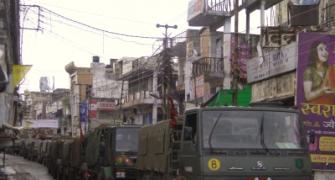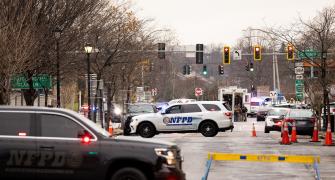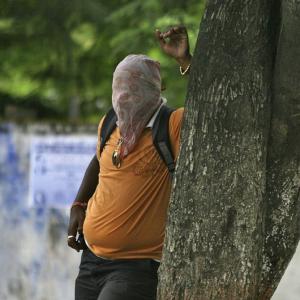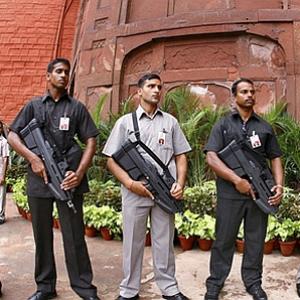Sharat Pradhan secures exclusive access to the Justice Vishnu Sahai report and discovers it blames two BJP MLAs, a former BSP MP and his cohorts, local intelligence officials and the media for the horrific Muzaffarnagar riots of 2013, but attributes no blame to the Samajwadi Party government in the state.

The one-man judicial commission, constituted to probe the factors that led to large-scale communal violence in Muzaffarnagar and four adjoining districts in August-September 2013, has indicated that the riots came in handy to polarise society in Western Uttar Pradesh.
The 775-page report, submitted to Uttar Pradesh Governor Ram Naik last week, mentions the role of two BJP MLAs and some Bahujan Samaj Party leaders in allegedly inciting and fuelling the communal violence that left 62 people dead, hundreds wounded and over 55,000 displaced from their homes for months in Muzaffarnagar and the four adjoining districts of Shamli, Baghpat, Meerut and Saharanpur.
Interestingly, no senior UP government official nor a single Samajwadi Party politician stand indicted in the report, even as it mentions a Samajwadi Party leader, Rashid Siddiqui, as among those who delivered provocative speeches at Shaheed Chowk in Muzaffarnagar on August 31, 2013 along with BSP and Congress leaders, against whom criminal cases were registered by the local police.
Retired Allahabad high court judge Vishnu Sahai, who headed the commission, has maintained utmost secrecy about his findings. The governor and state government, to which the report was duly forwarded shortly after submission, are just as tight lipped about the contents.
This correspondent secured access to the document, which took exactly two years to prepare. If there was anyone who has been blamed for the riots, it were two BJP MLAs, a former BSP MP and his cohorts, local intelligence officials and the media. An oblique reference has been made to a veteran Congress leader and his son.
'The findings were arrived at after making 11 visits to Muzaffarnagar, where each time, I held 7-10 day sittings at the camp office, to record evidence of as many as 377 witnesses from (the) public and 101 government officials,' Justice Sahai notes.
At times, the report suggests how certain actions of the UP government only helped sharpen the communal divide and boost the politics of polarisation.
The report has identified 14 causes for the riots, which were seen as among the worst in the history of independent India.
The foremost of these, according to the report, was 'the communal divide between Muslims and Hindus becoming acute on account of some incidents which had taken place between them some months prior to 27.08.2013 (the date of the Kawal incident, that triggered the violence) in UP, specially in the districts of Muzaffarnagar and Shamli.'
Referring to the Kawal village incident, Justice Sahai points out, 'It was crystal clear that although the main reason for the communal riots was the Kawal incident, which took place in village Kawal in district Muzaffarmagar on 27.08.2013 in which three boys, Shahnawaz (Muslim) , Sachin and Gaurav (Hindus) were killed, some months prior to 27.08.2013, (the) communal divide between Muslims and Hindus had become acute in Western UP, specially in the districts of Muzaffarnagar and Shamli.'
'The Kawal incident merely acted as a catalyst and also resulted in polarisation of society into segments -- Hindus and Muslims. It is this polarisation which led to communal riots.'
It is still not clear if the eve-teasing of Sachin's sister by Shahnawaz that provoked the murderous attack by Sachin and Gaurav, who subsequently themselves met the same fate in an act of reprisal by locals, or was it a collision of motorcycles belonging to the two sides, that triggered the violence.
The flashing on Whats App and YouTube of a video clip, showing the brutal killing of an individual (actually in Pakistan) and claiming it as that of the lynching of the two Hindu boys Sachin and Gaurav in Kawal village has been described as 'one of the potent reasons for the communal riots' in Justice Sahai's report.
According to Justice Sahai, inquiries made in this connection by the then Inspector General of Police Meerut Zone Brij Bhushan revealed that 'the clip related to some incident in August 2012 and it was uploaded on You Tube by one Shivam along with Sangeet Som, MLA. From the language it appears that the incident shown in it pertains to some Western province of Pakistan.'
'He (IGP Brij Bhushan) immediately directed SSP Muzaffarnagar and CO (City) Muzaffaranagar that this video clip be deleted,' Justice Sahai's report adds.
'He also had a talk with IG (STF) regarding the deletion of this video clip. CO (City) got this video clip deleted on the ground that it was promoting unrest and tension between Hindus and Muslims in Muzaffarnagar and adjoining districts. But, by the time it was deleted, a lot of tension had already been created between Hindus and Muslims in Muzaffarnagar and adjoining districts on account of it.'
'In order to ensure that people may not get a wrong impression from the aforesaid video clip on the night of 29.08,2013,' the report says, 'the district magistrate and SSP of Muzaffarnagar had it conveyed through newspapers and TV channels that the said video clip did not pertain to (the) Kawal incident.'
BJP MLA Sangeet Som was later arrested on this very charge, following which the Akhilesh Yadav administration in UP also slapped charges under the National Security Act on him.
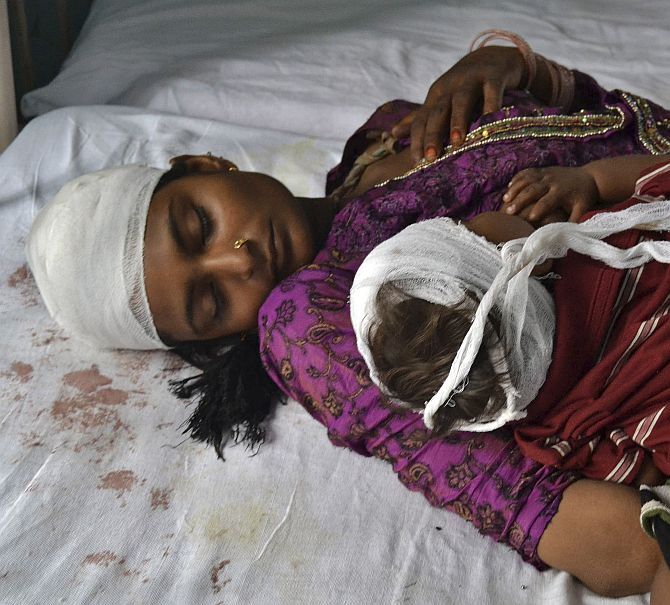
The inquiry commission also mentions provocative speeches delivered by Hindu and Muslim leaders as another key reason for the communal violence.
'It is regrettable that neither Hindu nor Muslim leaders showed restraint. They gave no thought to the fact that communal harmony was the need of the hour and since provocative speeches would endanger it, it would refrain from giving such speeches,' laments Judge Sahai, whose focus remains on BJP leaders Sangeet Som and Suresh Rana besides former Bahujan Samaj Party MP Qadir Rana.
The commission also pointedly blames intelligence officials for failing to make correct assessments of the brewing communal situation in Muzaffarnagar. That was explicitly in reference to the 'panchayat' convened in Nagla Mandaur village on September 7, 2013.
'Failure of intelligence agencies was a major reason for the riots. The evidence of Shri Brij Bhushan, IG, Meerut Zone, shows that intelligence input was that 15,000-20,000 people would be attending the panchayat at Nagla Mandaur on 07.09,2013, but actually 40,000 to 50,000 people attended it. Since 40,000-50,000 people actually attended the panchayat, in view of the commission, all planning was bound to fail.'
Justice Sahai defends the district magistrate and senior superintendent of police as well as senior officials at the state headquarters, even though apparently none of them made their own assessment of the situation.
How the judge expected senior IAS and IPS officers to blindly follow the intelligence inputs provided by a local intelligence inspector without using their own expertise is rather strange.
'The authorities in my view cannot be faulted when people in double the strength (of what had been reported by the intelligence agencies) attended the panchayat,' asserts Justice Sahai in defence of the senior officers.
As if to add insult to injury, the report states, 'Since provocative speeches delivered by Hindu leaders (specially Jats) during the panchayat provoked the Hindu crowd,it was only natural that while the Hindu crowd was returning from panchayat, grievous riots took place on the date of the panchayat i.e. 07.09.2013. Failure of intelligence was certainly, in my opinion, a major given reason for the riots.'
The report squarely places all the blame on the local intelligence inspector. Dismissing the inspector's plea that the huge gathering at the Nagla Mandaur panchayat on September 7 was impromptu, the judge notes, 'In my view the fact that between 40,000 and 50,000 people gathered at the panchayat of Nagla Mandaur on 07.09.2013 shows that it was not a gathering which took place on the spur of the moment, but was the result of elaborate prior planning about which intelligence inspector Prabal Pratap Singh could have been vigilant.'
Relying entirely on the evidence of witnesses (mostly government officials) Justice Sahai has made scathing remarks against the print and social media.
'The social and print media indulged in exaggerating reports about the incidents relating to riots and in also spreading false rumours about (the) riots,' the report point out.
The evidence cited by Justice Sahai in this regard was given by then director general of police Devraj Nagar, the principal secretary (home) R M Srivastava and then senior superintendent of police, Muzaffarnagar, Praveen Kumar.
'I am of the view that a certain amount of restraint was required from the media in reporting incidents pertaining to the riots and its duty was to contain rumours, but regretfully, the media became oblivious of its social responsibility and some of its reporting flared the riots,' the report states.
The only occasion where the report question the state government's decision relates to the transfer of the then DM and SSP Muzaffarnagar when communal broke out initially on August 27, 2013.
While terming the transfer of then DM Surendra Singh and then SSP Manjul Saini as among the factors responsible for the riots, Justice Sahai justify the transfers as having been ordered in view of a particular government order which in para 7 says, 'in case an incident of communal nature takes place in a district, stern action would be taken against the DM/SSP/SP.'
However, he makes it a point to add, 'their transfer resulted in antagonising the Hindu community (specially Jats) against the government and this antagonism on their part was a major reason for the riots.'
Justice Sahai states that the local Hindu community attributed these transfers to the detention of eight Muslims by the police in connection with the killing of Sachin and Gaurav in the Kawal incident.
Soon after the two officers were transferred from Muzaffarnagar, the eight individuals were let off on the plea that their names did not figure in the First Information Report registered by the victim's father.
'Actually not eight but 14 persons were released and the reason for their release was that they were neither named in the FIR nor there was any suspicion against them,' Justice Sahai states in his report.
'However,' the judge adds, 'on account of their release, Hindus in general and Jats in particular, were antagonised and the message which spread amongst them was that the administration and the government were pro-Muslim and the former as acting under the influence of the latter.'
While these eight (or 14) individuals were let off, Justice Sahai notes the administration's decision to insert the names of Sachin and Gaurav's family members in the FIR lodged by Shahnawaz's kin.
'I am of the view that insertion of the names in the FIR relating to Shahnawaz's murder of persons other than Sachin and Gaurav definitely antagonised (the) Hindu community (specially Jats) and sent the message that the administration and the government was pro-Muslim,' observes Justice Sahai, who choses to not hold anyone responsible for that decision.
From the averments made before the commission and the conclusions drawn by Justice Sahai, it is evident that the actions ordered by the UP government were not without a slant and an objective handling of the situation at the very outset on August 27, 2013 could have perhaps averted the situation from taking such a horrific turn as it did.

